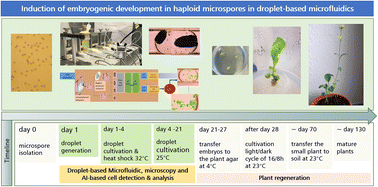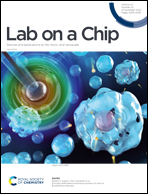Induction of embryogenic development in haploid microspore stem cells in droplet-based microfluidics†
Abstract
This work presents the application of droplet-based microfluidics for the cultivation of microspores from Brassica napus using the doubled haploid technology. Under stress conditions (e.g. heat shock) or by chemical induction a certain fraction of the microspores can be reprogrammed and androgenesis can be induced. This process is an important approach for plant breeding because desired plant properties can be anchored in the germline on a genetic level. However, the reprogramming rate of the microspores is generally very low, increasing it by specific stimulation is, therefore, both a necessary and challenging task. In order to accelerate the optimisation and development process, the application of droplet-based microfluidics can be a promising tool. Here, we used a tube-based microfluidic system for the generation and cultivation of microspores inside nL-droplets. Different factors like cell density, tube material and heat shock conditions were investigated to improve the yield of vital plant organoids. Evaluation and analysis of the stimuli response were done on an image base aided by an artificial intelligence cell detection algorithm. Droplet-based microfluidics allowed us to apply large concentration programs in small test volumes and to screen the best conditions for reprogramming cells by the histone deacetylase inhibitor trichostatin A and for enhancing the yield of vital microspores in droplets. An enhanced reprogramming rate was found under the heat shock conditions at 32 °C for about 3 to 6 days. In addition, the comparative experiment with MTP showed that droplet cultivation with lower cell density (<10 cells per droplet) or adding media after 3 or 6 days significantly positively affects the microspore growth and embryo rate inside 120 nL droplets. Finally, the developed embryos could be removed from the droplets and further grown into mature plants. Overall, we demonstrated that the droplet-based tube system is suitable for implementation in an automated, miniaturized system to achieve the induction of embryogenic development in haploid microspore stem cells of Brassica napus.



 Please wait while we load your content...
Please wait while we load your content...